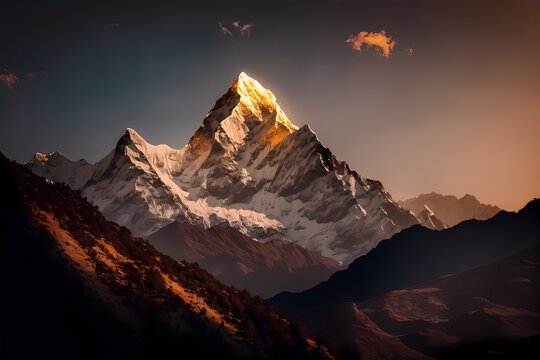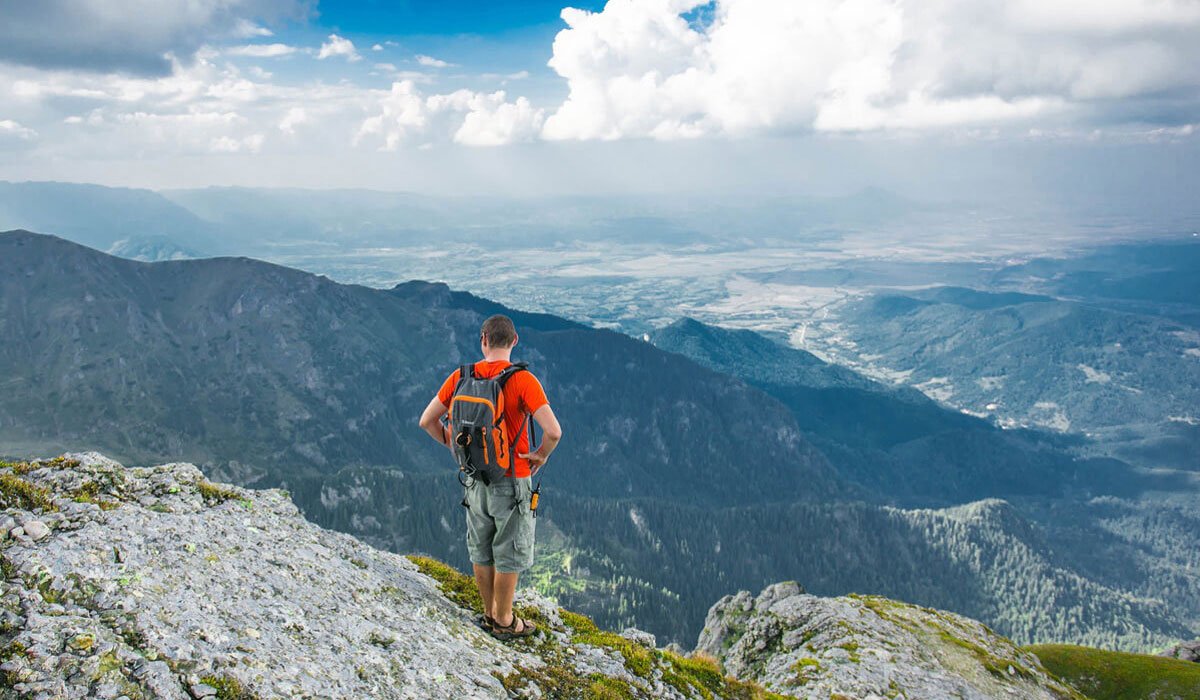1.Weather:
a.Spring (March to May):
– Spring is one of the best times for the Annapurna Base Camp Trek. During this season, the weather is generally mild and stable, with clear skies and comfortable temperatures.
– Daytime temperatures range from 15°C to 20°C (59°F to 68°F) in the lower elevations, making it pleasant for trekking.
– The spring season brings blooming rhododendron forests, adding vibrant colors to the landscape and enhancing the trekking experience.
– However, it’s essential to be prepared for occasional rain showers, especially towards the end of May, as the monsoon season approaches.
b. Autumn (September to November):
– Autumn is another popular season for trekking to Annapurna Base Camp, known for its clear skies, stunning views, and stable weather conditions.
– Temperatures during the day range from 15°C to 20°C (59°F to 68°F) in lower elevations, similar to spring, providing comfortable trekking conditions.

– The skies are generally clear, offering panoramic views of the snow-capped peaks of the Annapurna and Dhaulagiri ranges.
– Autumn is also the peak trekking season in Nepal, so expect more crowds on the trail and in tea houses.
c.Winter (December to February):
– Winter brings colder temperatures and drier weather to the Annapurna region. Daytime temperatures in lower elevations range from 5°C to 10°C (41°F to 50°F), with colder nights.
– The skies are usually clear during the winter months, offering excellent visibility of the surrounding mountains.
– While the trekking trails are less crowded compared to the peak seasons, be prepared for cold temperatures, especially at higher elevations, and ensure proper gear for warmth.
d.Summer/Monsoon (June to August):
– The summer season in Nepal coincides with the monsoon season, bringing heavy rainfall to the Annapurna region.
– Trekking during this time can be challenging due to frequent rain showers, muddy trails, and the risk of landslides.
– Daytime temperatures in lower elevations range from 20°C to 25°C (68°F to 77°F), but the humidity can make it feel warmer.
– Despite the challenges, some trekkers enjoy the lush greenery and fewer crowds on the trails during the monsoon season.
Overall, while spring and autumn are considered the best times for the Annapurna Base Camp Trek due to favorable weather conditions and stunning scenery, each season offers a unique experience for trekkers to explore the Himalayas.
2.Temperature:
a.Spring (March to May):
– During the spring season, temperatures along the Annapurna Base Camp Trek route are generally mild and pleasant.
– In lower elevations, daytime temperatures range from 15°C to 20°C (59°F to 68°F), providing comfortable conditions for trekking.

– However, temperatures can drop significantly at higher elevations, especially during the early mornings and evenings, so it’s essential to be prepared with warm layers.
b.Autumn (September to November):
– Autumn brings similar temperature ranges to spring, with mild and comfortable conditions for trekking.
– Daytime temperatures in lower elevations are typically between 15°C to 20°C (59°F to 68°F), ideal for enjoying the trekking experience.
– As with spring, temperatures can decrease at higher altitudes, so trekkers should carry appropriate clothing to stay warm, especially during the nights.
c.Winter (December to February):
– Winter months bring colder temperatures to the Annapurna region, particularly at higher elevations.
– Daytime temperatures in lower elevations range from 5°C to 10°C (41°F to 50°F), while nighttime temperatures can drop below freezing, especially at higher altitudes.
– Trekkers should be prepared for chilly conditions throughout the day and ensure they have adequate cold-weather gear, including insulated jackets, hats, gloves, and warm sleeping bags.
d.Summer/Monsoon (June to August):
– Despite warmer daytime temperatures ranging from 20°C to 25°C (68°F to 77°F) in lower elevations, the humidity during the summer monsoon season can make it feel much hotter.
– However, temperatures at higher altitudes are cooler compared to lower elevations, providing some relief from the heat.

– Trekkers should be prepared for sudden changes in weather, including heavy rainfall, which can significantly impact temperature perception and trekking conditions.
In brief, understanding temperature variations during different seasons is crucial for planning a successful Annapurna Base Camp Trek. Trekkers should pack accordingly, considering the season they plan to trek in and the potential temperature fluctuations they may encounter along the route.
3.Scenery:
a.Spring (March to May):
– Spring is one of the most visually stunning times to trek to Annapurna Base Camp due to the vibrant and colorful scenery.
– The trekking trails are adorned with blooming rhododendron forests, adding shades of red, pink, and white to the landscape.
– Lush greenery blankets the hillsides, creating a picturesque backdrop against the snow-capped peaks of the Annapurna and Dhaulagiri ranges.
– Waterfalls and streams are in full flow during this season, adding to the enchanting ambiance of the trek.
b.Autumn (September to November):
– Autumn is another excellent time to experience the breathtaking scenery of the Annapurna region.
– The skies are generally clear, offering unobstructed views of the towering Himalayan peaks.
– The landscapes are adorned with golden hues as the foliage begins to change colors, creating a mesmerizing contrast against the azure sky and white snow-capped peaks.
– Trekkers can enjoy panoramic views of iconic mountains such as Annapurna I, Machapuchare (Fishtail), and Hiunchuli along the trail.
c.Winter (December to February):
– While winter brings colder temperatures to the region, it also offers a unique and tranquil trekking experience.
– The landscapes are blanketed in snow, creating a pristine and serene atmosphere along the trekking trails.
– Clear skies during the winter months provide excellent visibility of the surrounding mountains, offering mesmerizing views of snow-capped peaks against the backdrop of blue skies.
– Trekkers can enjoy quieter trails and tea houses during this season, making it ideal for those seeking solitude and a peaceful trekking experience.
d.Summer/Monsoon (June to August):
– The summer monsoon season brings lush greenery and abundant vegetation to the Annapurna region.
– While the trails may be muddy and slippery due to rainfall, the landscapes come alive with vibrant colors and blooming flowers.
– Waterfalls cascade down the mountainsides, creating dramatic scenes along the trekking route.
– Trekkers can witness the raw power of nature as they trek through misty forests and cloudy landscapes, offering a unique perspective of the Annapurna region.
Overall, each season offers its own charm and beauty, providing trekkers with unforgettable experiences amidst the stunning scenery of the Annapurna Base Camp Trek.
4.Crowds:
The popularity of the Annapurna Base Camp Trek varies significantly throughout the year, shaping the overall trekking experience. During the peak seasons of spring (March to May) and autumn (September to November), the trails are bustling with trekkers from around the world. The allure of favorable weather conditions and breathtaking scenery draws a large influx of outdoor enthusiasts eager to explore the Himalayan landscapes. However, this surge in visitors also means that popular sections of the trail, such as Ghorepani and Deurali, can become crowded, and securing accommodations may require booking well in advance. While the camaraderie among fellow trekkers adds to the social atmosphere, it’s essential to anticipate potential challenges such as limited availability of lodging and dining options during these bustling seasons.
In contrast, the winter months (December to February) offer a quieter trekking experience with fewer crowds along the trails. As temperatures drop and snow dusts the landscape, the Annapurna region takes on a serene and tranquil ambiance. While some lodges may close or operate with reduced capacity during this season, trekkers can still find accommodations along the route. The winter months provide an opportunity for those seeking solitude to immerse themselves in the raw beauty of the Himalayas without the hustle and bustle of peak tourist seasons. However, trekkers should be prepared for colder temperatures and potentially challenging terrain, as well as the possibility of encountering snow at higher elevations.
5.Permit and logistics:
Obtaining the necessary permits and managing logistics are essential aspects of planning a successful Annapurna Base Camp Trek. Before embarking on the journey, trekkers must secure the required permits from the Nepal Tourism Board and the Annapurna Conservation Area Project (ACAP). These permits help fund conservation efforts and ensure the sustainability of the region’s natural resources. Additionally, trekkers should be aware of any entry fees or taxes that may apply, depending on the specific route chosen. Proper planning and organization are crucial for navigating logistics such as transportation, accommodations, and meals along the trekking route. While some trekkers opt for guided tours that handle these logistics, others choose to trek independently and arrange accommodations and meals at local teahouses along the way. Regardless of the chosen approach, it’s essential to plan ahead, especially during peak seasons, to secure accommodations and avoid any logistical challenges during the trek.
6.Personal preferences:
Personal preferences play a significant role in determining the best time to embark on the Annapurna Base Camp Trek. Each season offers its own unique advantages and challenges, catering to different interests and preferences. For trekkers who enjoy vibrant landscapes and moderate temperatures, the spring season (March to May) is an ideal choice. During this time, blooming rhododendron forests paint the hillsides with vivid colors, creating a picturesque backdrop against the snow-capped peaks. Additionally, the stable weather conditions and clear skies provide excellent visibility of the surrounding mountains, enhancing the overall trekking experience. However, trekkers should be prepared for occasional rain showers, especially towards the end of May as the monsoon season approaches.
Alternatively, for those who prefer quieter trails and a more peaceful ambiance, the winter months (December to February) offer a unique trekking experience. While colder temperatures and potential snowfall may deter some trekkers, the pristine and tranquil landscapes of the Annapurna region are unparalleled during this season. With fewer crowds on the trails, trekkers can immerse themselves in the serene beauty of the Himalayas, enjoying uninterrupted views of snow-capped peaks and frozen waterfalls. However, it’s essential to pack appropriately for the cold weather and be prepared for potential challenges such as icy trails and limited accommodation options in some areas. Ultimately, personal preferences such as tolerance for crowds, weather conditions, and desired scenery should guide trekkers in choosing the best time to embark on the Annapurna Base Camp Trek, ensuring a fulfilling and memorable adventure tailored to individual preferences.
